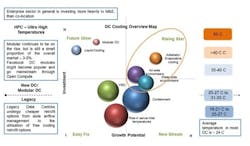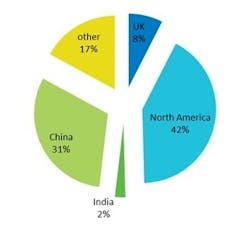BSRIA: Hyperscale data centers are changing the cooling landscape
In a recently published market study, BSRIA shows that hyperscale data centers are changing the market for precision cooling and that over the next 5 to 10 years, the use of traditional computer room air conditioning (CRAC) units will drop dramatically as data centers opt for a combination of free cooling, liquid cooling and chilled-water cooling.
Hyperscale data centers like those operated by Apple, Google, Facebook, Amazon and others are often deploying new technologies, BSRIA noted, such as modular, outdoor air handling units (AHUs) and evaporative cooling. “This has driven a lot of change and enabled air conditioning manufacturers like McQuay, Trane, Carrier, JCI, Daikin and others to participate in the data center cooling market,” BSRIA noted. “Data centers in general are evolving rapidly. The standard design that was common in the last two decades is giving way to more-flexible configurations that more closely match the sophisticated needs of more-discerning, better-informed customers.”
Lone Hansen, worldwide market intelligence manager for BSRIA’s IT cable group, commented, “Most of the large hyperscale [American] data centers have a centralized team that will develop the specification with regards to IT equipment and networks, cooling and power. The specification will typically be rolled out globally and include several—often three to four—approved suppliers in each product category. A global footprint is an important part of the selection criteria. Most value multiple-source relationships as opposed to single-source relationships. Some of the products are sourced direct from the suppliers to reduce the cost while others are bought through distribution.”
The figure immediately below, created by BSRIA, illustrates some of the new potential technologies and their positioning in terms of typical application and temperature operating range.
BSRIA estimates the precision cooling products installed in data centers at US$1.9 billion, covering the 10 largest markets worldwide in 2014; BSRIA expects these markets to show healthy growth through 2017.
The pie chart on this page shows the regional market share for precision cooling. The yellow “other” slice comprises Russia, Germany, France, Australia and Brazil; BSRIA stated, “of which Germany is by far the largest, accounting alone for 6 percent of the global market.
“The US$1.9 billion does not include precision cooling products installed in non-IT sectors such as healthcare and laboratories, manufacturing, industrial, semiconductors, education,” BSRIA said. “Though smaller than the data center market, this market is nevertheless substantial and its dimensions are also estimated in the study.”
You can get more information on the study by emailing BSRIA's Andrew Giles.


